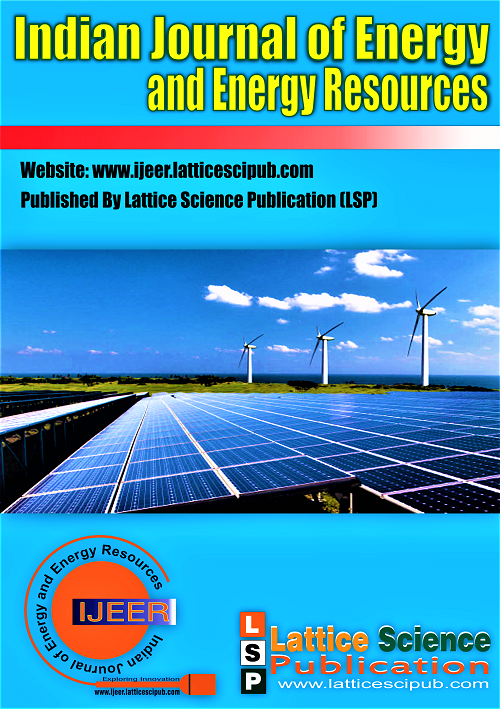Case Study of Solar Integration in HVAC Systems: Efficiency and Sustainability Outcomes
Main Article Content
Abstract
This study looks into the environmental advantages, economic feasibility, and technical viability of using solar energy to charge HVAC (Heating, Ventilation, and Air Conditioning) batteries. It also covers issues like the unpredictable nature of solar energy and the requirement for energy-storage technology. This study adds to the ongoing efforts to develop a more resilient and sustainable energy infrastructure by encouraging the incorporation of renewable energy sources into HVAC systems. PV (Photovoltaic) panels collect solar energy, a charge controller manages energy effectively, and a battery storage unit is adapted to meet HVAC needs make up the system. The purpose of solar energy integration into HVAC systems is to decrease dependency on the traditional grid, reduce environmental effects, and improve overall energy efficiency. Intelligent charge control algorithms, real-time monitoring, and predictive maintenance capabilities are some of the solar-powered charging system's key characteristics. These characteristics ensure that the HVAC system runs smoothly and leave as little of an environmental impact as possible while optimizing energy utilization. The system's scalability and adaptability to a wide range of customer needs enable it to serve HVAC applications in both residential and commercial settings.
Downloads
Article Details

This work is licensed under a Creative Commons Attribution-NonCommercial-NoDerivatives 4.0 International License.
How to Cite
References
M. A. Habib, M. A. Haque, B. Imteyaz, M. Hussain, and M. M. Abdelnaby, “Potential of Integrating Solar Energy into Systems of Thermal Power Generation, CoolingRefrigeration, Hydrogen Production, and Carbon Capture,” J. Energy Resour. Technol. Trans. ASME, vol. 145, no. 11, 2023, doi: 10.1115/1.4062381. https://doi.org/10.1115/1.4062381
Q. Al-Yasiri, M. Szabó, and M. Arıcı, “A review on solar-powered cooling and air-conditioning systems for building applications,” Energy Reports, vol. 8, pp. 2888–2907, 2022, doi: 10.1016/j.egyr.2022.01.172. https://doi.org/10.1016/j.egyr.2022.01.172
A. Gurung and Q. Qiao, “Solar Charging Batteries: Advances, Challenges, and Opportunities,” Joule, vol. 2, no. 7, pp. 1217–1230, 2018, doi: 10.1016/j.joule.2018.04.006. https://doi.org/10.1016/j.joule.2018.04.006
M. Lokeshreddy, P. J. R. P. Kumar, S. A. M. Chandra, T. S. Babu, and N. Rajasekar, “Comparative study on charge controller techniques for solar PV system,” Energy Procedia, vol. 117, pp. 1070–1077, 2017, doi: 10.1016/j.egypro.2017.05.230. https://doi.org/10.1016/j.egypro.2017.05.230
Nguyen Duc Minh, Trinh Trong Chuong, Bui Van Huy, Quach Duc Cuong, and Bui Dinh Thanh, “Research and Design of Inverter Applied in Solar PV Systems Connected to Distribution Grid,” J. Electr. Eng., vol. 7, no. 1, 2019, doi: 10.17265/2328-2223/2019.01.006. https://doi.org/10.17265/2328-2223/2019.01.006
V. Sharma, M. H. Haque, S. M. Aziz, and T. Kauschke, “Smart inverter and battery storage controls to reduce financial loss due to overvoltage-induced PV curtailment in distribution feeders,” Sustain. Energy, Grids Networks, vol. 34, 2023, doi: 10.1016/j.segan.2023.101030. https://doi.org/10.1016/j.segan.2023.101030
W. Viriyautsahakul, W. Panacharoenwong, W. Pongpiriyakijkul, S. Kosolsaksakul, and W. Nakawiro, “A Simulation Study of Inverter Air Conditioner Controlled to Supply Reactive Power,” Procedia Comput. Sci., vol. 86, pp. 305–308, 2016, doi: 10.1016/j.procs.2016.05.083. https://doi.org/10.1016/j.procs.2016.05.083
M. A. Hannan et al., “Battery energy-storage system: A review of technologies, optimization objectives, constraints, approaches, and outstanding issues,” J. Energy Storage, vol. 42, 2021, doi: 10.1016/j.est.2021.103023. https://doi.org/10.1016/j.est.2021.103023
A. Y. Sulaiman et al., “A solar powered off-grid air conditioning system with natural refrigerant for residential buildings: A theoretical and experimental evaluation,” Clean. Energy Syst., vol. 5, 2023, doi: 10.1016/j.cles.2023.100077. https://doi.org/10.1016/j.cles.2023.100077
K. A. Nitesh and Ravichandra, “A Study on Battery Controller Design for the Estimation of State of Charge (SoC) in Battery Management System for Electric Vehicle (EV)/Hybrid EV (HEV),” SN Comput. Sci., vol. 2, no. 3, 2021, doi: 10.1007/s42979-021-00600-0. https://doi.org/10.1007/s42979-021-00600-0
R. M. Ramli and W. A. Jabbar, “Design and implementation of solar-powered with IoT-Enabled portable irrigation system,” Internet Things Cyber-Physical Syst., vol. 2, pp. 212–225, 2022, doi: 10.1016/j.iotcps.2022.12.002. https://doi.org/10.1016/j.iotcps.2022.12.002
C. F. Yenku, M. D. Fendji, A. Fopah-Lele, and D. Tsuanyo, “Charge-Controller Optimization on Lead-Acid Battery in Solar PV Systems: Temperature Effects and Efficiency Improvement,” E3S Web Conf., vol. 354, 2022, doi: 10.1051/e3sconf/202235401003. https://doi.org/10.1051/e3sconf/202235401003
S. Subramanaya, “Introduction to HVAC Systems: Chapter 2,” 2006.
B. Fan, X. Jin, X. Fang, and Z. Du, “The method of evaluating operation performance of HVAC system based on exergy analysis,” Energy Build., vol. 77, pp. 332–342, 2014, doi: 10.1016/j.enbuild.2014.03.059. https://doi.org/10.1016/j.enbuild.2014.03.059
S. K. Alghoul, “A Comparative Study of Energy Consumption for Residential HVAC Systems Using EnergyPlus,” Am. J. Mech. Ind. Eng., vol. 2, no. 2, p. 98, 2017, doi: 10.11648/j.ajmie.20170202.16. https://doi.org/10.11648/j.ajmie.20170202.16
S. Seyam, “Types of HVAC Systems,” HVAC Syst., 2018, doi: 10.5772/intechopen.78942. https://doi.org/10.5772/intechopen.78942
Ali, S. S., & Tyagi, D. R. (2020). The role of Energy Conservation Building Code 2017 in Indian Energy Policy. In International Journal of Recent Technology and Engineering (IJRTE) (Vol. 9, Issue 1, pp. 1799–1806). https://doi.org/10.35940/ijrte.a2212.059120 https://doi.org/10.35940/ijrte.A2212.059120
Dharan, B., & S, Jayalakshmi. (2020). Green IT-An Eco-friendly Practices and Methods for Environmental Sustainability. In International Journal of Innovative Technology and Exploring Engineering (Vol. 9, Issue 4, pp. 2889–2894). https://doi.org/10.35940/ijitee.d1785.029420 https://doi.org/10.35940/ijitee.D1785.029420
Kariuki, A., & Odhiambo, E. (2021). Assessment of Implementation of Energy Efficiency Measures, Savings Achieved and Barriers to Implementation at Various Firms in the Hospitality Industry in Kenya. In International Journal of Engineering and Advanced Technology (Vol. 10, Issue 4, pp. 10–23). https://doi.org/10.35940/ijeat.c2226.0410421 https://doi.org/10.35940/ijeat.C2226.0410421
Singh, H. P. (2022). Scope of Solar Energy and Wind Energy in District Raebareli (Uttar Pradesh). In Indian Journal of Energy and Energy Resources (Vol. 1, Issue 3, pp. 7–8). https://doi.org/10.54105/ijeer.c1004.051322 https://doi.org/10.54105/ijeer.C1004.051322
Kumar, P. R., & Padma, R. (2019). A Novel Control Method for Integration of Battery Energy Storage System in Microgrid for Energy Management System. In International Journal of Innovative Technology and Exploring Engineering (Vol. 9, Issue 2, pp. 4974–4977). https://doi.org/10.35940/ijitee.b9079.129219 https://doi.org/10.35940/ijitee.B9079.129219





